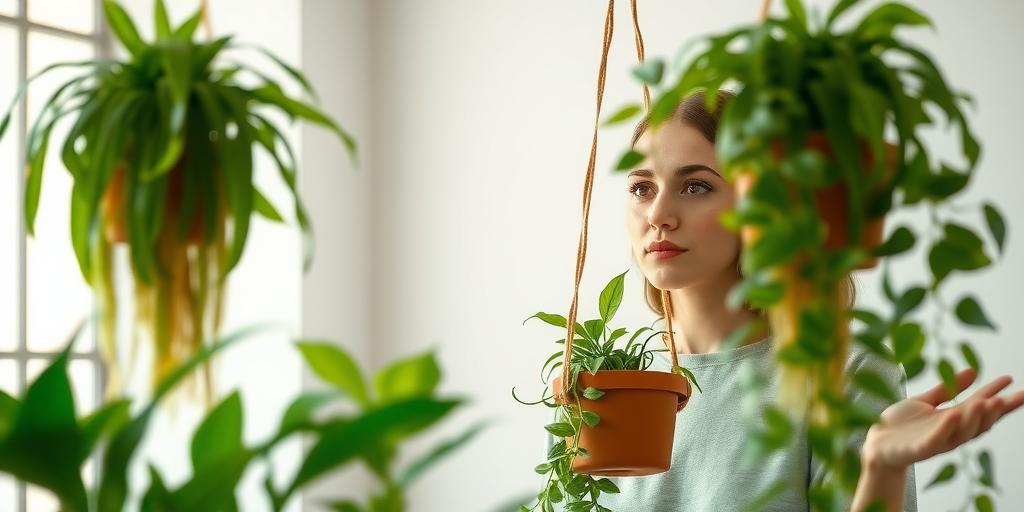
Best Low Light Hanging Plants to Brighten Your Office Space in 2025
Looking for the best low-light hanging plants for your office? Discover top picks that thrive in dim spaces, purify the air, and boost productivity—perfect for brightening up any workspace!
Introduction
Did you know that adding plants to your office can increase productivity by up to 15%? Even if your workspace lacks natural light, you can still enjoy the benefits of greenery with the right low-light hanging plants! From air-purifying champions to easy-care trailing beauties, this guide covers the best options to transform your office into a lush, inspiring environment. Let’s dive in!
Why Choose Low Light Hanging Plants for Your Office?
Benefits of Indoor Plants for Air Quality and Mood Enhancement
Indoor plants do more than just brighten up a workspace—they actively improve air quality by filtering out toxins and releasing oxygen. Studies have shown that having greenery in the office can reduce stress, boost productivity, and even enhance creativity. If you spend long hours at a desk, a few well-placed hanging plants can make your environment feel fresher and more inviting.
How Hanging Plants Save Space in Small Offices
Not every office has room for large potted plants or floor-standing greenery. Hanging plants are a fantastic solution because they utilize vertical space, keeping desks and shelves free for work essentials. Whether suspended from the ceiling, mounted on walls, or placed on high shelves, they add life to your workspace without cluttering it.
Why Low-Light Plants Are Ideal for Windowless or Dimly Lit Workspaces
Many offices lack natural sunlight, especially those in basements or interior rooms. Low-light plants thrive in these conditions because they’ve adapted to survive under tree canopies or in shaded areas in nature. Unlike sun-loving plants that wilt without direct light, these varieties stay lush and healthy even under fluorescent lighting.
Top 10 Low Light Hanging Plants for Offices
Devil’s Ivy (Epipremnum aureum) – Nearly Indestructible, Great for Beginners
If you’re new to plant care, Devil’s Ivy is a perfect choice. It can survive in almost any lighting condition (including low light) and forgives the occasional missed watering. Its trailing vines grow quickly, making it ideal for hanging baskets.
Spider Plant (Chlorophytum comosum) – Purifies Air and Produces Baby Offshoots
Spider plants are air-purifying champions, removing formaldehyde and xylene from indoor air. They also produce “pups” (small offshoots) that can be propagated, giving you more plants to decorate your office or share with coworkers.
Philodendron Heartleaf – Fast-Growing and Adaptable to Low Light
With heart-shaped leaves and a vining habit, this plant adds a touch of nature without demanding much attention. It grows well in low light and only needs watering when the top inch of soil is dry.
Pothos (Golden Pothos) – Thrives in Fluorescent Lighting
Similar to Devil’s Ivy but with variegated yellow-green leaves, Golden Pothos is another hardy option. It does well under office lighting and can grow several feet long, creating a lush, cascading effect.
String of Pearls (Senecio rowleyanus) – Unique Trailing Succulent for a Modern Look
This eye-catching succulent features bead-like leaves that drape beautifully from hanging planters. While it prefers bright indirect light, it can adapt to lower light—just water sparingly to avoid root rot.
ZZ Plant (Zamioculcas zamiifolia) – Drought-Tolerant and Ultra-Low Maintenance
The ZZ plant is practically unkillable—it stores water in its rhizomes, so it can go weeks without watering. Its glossy leaves add a sleek, modern touch to any office.
Peperomia – Compact and Colorful with Minimal Care Needs
Peperomias come in many varieties, some with striking red or textured leaves. They stay small, making them perfect for compact spaces, and only need occasional watering.
English Ivy (Hedera helix) – Excellent for Air Purification
English Ivy is known for filtering airborne mold and pollutants. It grows well in hanging baskets but can be prone to spider mites, so keep an eye out for pests.
Maidenhair Fern (Adiantum) – Delicate Fronds Add Elegance
This fern has soft, lacy leaves that bring a graceful touch to any office. It prefers consistent moisture and humidity, so misting occasionally helps in dry indoor environments.
Rhipsalis (Mistletoe Cactus) – Unusual Cascading Cactus for Low Light
Unlike most cacti, Rhipsalis thrives in shade. Its long, trailing stems create a whimsical look, and it only needs watering when the soil is completely dry.
How to Care for Low Light Hanging Plants
Watering Tips to Prevent Over/Underwatering
Overwatering is the most common killer of office plants, especially in low light where evaporation is slow. Always check the soil before watering—stick your finger an inch deep; if it’s dry, it’s time to water. For succulents like String of Pearls or ZZ plants, wait until the soil is completely dry.
Best Soil and Potting Mixes for Healthy Growth
A well-draining potting mix is essential to prevent root rot. For tropical plants like Pothos or Philodendron, a standard indoor potting mix works. For succulents and cacti, use a gritty, fast-draining mix with perlite or sand.
Simple Fertilization Routines for Slow-Growing Plants
Low-light plants grow slower, so they need less fertilizer. A diluted liquid houseplant fertilizer every 2-3 months during spring and summer is usually sufficient. Skip fertilizing in winter when growth slows further.
Pruning and Maintenance for Lush, Full Foliage
Regularly trim leggy vines to encourage bushier growth. Remove yellow or dead leaves to keep plants healthy. For fast growers like Devil’s Ivy, occasional pruning prevents them from becoming too unruly.
Creative Ways to Display Hanging Plants in Your Office
Macramé Hangers for a Boho-Chic Vibe
Macramé plant hangers add texture and style while keeping plants at eye level. They work especially well near windows or in corners that need a decorative touch.
Wall-Mounted Hooks and Ceiling Planters for Space Efficiency
If floor or desk space is limited, wall-mounted planters or ceiling hooks maximize vertical space. Try arranging several small planters at different heights for visual interest.
Tiered Plant Stands for a Mini Indoor Garden
A tiered stand lets you group multiple hanging plants together, creating a lush, layered effect. Mix different trailing varieties for contrast.
Combining Different Trailing Plants for Visual Interest
Pair plants with varying leaf shapes and colors—like the round pearls of String of Pearls with the heart-shaped leaves of Philodendron—for a dynamic display.
Common Mistakes to Avoid with Office Hanging Plants
Overwatering in Low-Light Conditions
Since low-light plants dry out slower, it’s easy to overwater them. Always err on the side of underwatering—most can recover from dryness but struggle with soggy roots.
Choosing Plants That Need More Light Than Your Office Provides
Avoid plants labeled as “bright indirect light” if your office is dim. Stick to true low-light varieties like ZZ plants or Pothos to ensure they thrive.
Ignoring Pest Prevention (Like Spider Mites on Ivy)
Pests like spider mites love English Ivy and other hanging plants. Wipe leaves occasionally with a damp cloth and inspect for webbing or tiny bugs.
Forgetting to Rotate Plants for Even Growth
Plants in low light tend to grow toward the nearest light source. Rotate them every few weeks to prevent lopsided growth and ensure even foliage.
Conclusion
Brightening up your office with low-light hanging plants is an easy and rewarding way to boost your workspace’s vibe and air quality. Whether you opt for a hardy pothos or an elegant fern, these green companions thrive with minimal effort—perfect for busy professionals. Ready to transform your office into a lush oasis? Pick your favorite plant and get started today!
